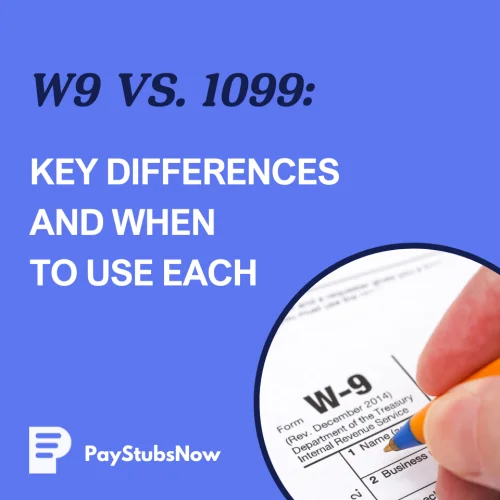


Ever wonder why you fill out stacks of paperwork just to get paid as a contractor? The difference between a W9 and a 1099 might be the most important detail you're overlooking.
Knowing the basics of W-9 vs. 1099 can save you from headaches, confusion, and even tax trouble down the road. If you plan to work for yourself—or pay someone who does—understanding these forms is the first step to getting it right.
Main Takeaways:

Form W-9 is a simple tax document that collects your identifying information before you get paid as a contractor. You'll provide your name, address, and Taxpayer Identification Number (TIN) on this form.
If you're a freelancer, independent contractor, or vendor providing services in the US, you'll need to complete a W-9. This applies whether you're an individual using your Social Security Number or a business using an Employer Identification Number.
The information you provide helps businesses accurately report payments they make to you at tax time. They'll use these details to create your 1099 form later. The business that hires you keeps this form on file for their records to prepare accurate 1099s. They don't send it to the IRS.
Businesses should retain each completed W-9 for at least four years after the last payment to the contractor to support any future IRS inquiries or 1099 filings.
Foreign contractors or vendors who aren’t U.S. taxpayers should not complete a W-9. Instead, they must submit Form W-8BEN (for individuals) or Form W-8BEN-E (for entities) to certify their foreign status for withholding and reporting purposes.
Form 1099 is a tax reporting tool for businesses. It's used to report income paid to independent contractors, freelancers, or any other non-employee who provides services and receives payment of $600 or more in a tax year.
The 1099 form comes in several variations tailored for different types of non-employment income reporting. Among the most common are:
Payments for services belong on Form 1099-NEC, while Form 1099-MISC is used for rents, prizes, attorney fees, or other miscellaneous income not tied to direct services.
If you paper-file your 1099s with the IRS, you must also include Form 1096 (Annual Summary and Transmittal of U.S. Information Returns) to summarize the total number and dollar amount of all 1099s submitted.

Understanding the W9 vs. 1099 differences helps you navigate tax season more confidently. These forms serve distinct but connected purposes in the tax reporting process.
The W-9 collects your information before you start work. The 1099 reports how much you were paid after the work is done.
Think of the W-9 as setting up your tax identity with a client. The 1099 then tracks what that client paid you during the year.
This division of responsibility ensures both parties have the correct information for tax reporting.
You should complete a W-9 before receiving your first payment from a new client. This gives them the information they need for their records.
If your business files 10 or more total information returns in a year—including W-2s, 1099s, and other IRS information forms—you are required to e-file through the Information Returns Intake System (IRIS) or approved e-file software.
Penalties for late or incorrect 1099 forms can be steep and increase each year.
For returns due in 2025 (filed January 2026):
For returns due in 2026 (filed January 2027):
These penalties apply separately for not filing with the IRS and for not providing copies to recipients, meaning the total fine can effectively double.
The 1099 form vs. W9 comparison shows different information requirements:
W-9 collects:
1099 reports:
Important Note: If your W-9 information doesn't match IRS records, your client may need to withhold 24% of your payments as backup withholding and send it directly to the IRS.

The relationship between these forms creates a complete tax reporting system. Here's how they work together:
This process ensures the IRS can match the income reported by your client with the income you report on your tax return.
With Paystubsnow, businesses can collect contractor data securely, generate accurate 1099s, and keep every form organized in one platform, simplifying the entire process from start to finish.
Business Tip: The U.S. Small Business Administration advises employers to collect tax and payment information from contractors before any work begins. Proper documentation not only ensures IRS compliance but also keeps all business relationships transparent and professional.
Paystubsnow helps you generate, store, and manage accurate W-9 and 1099 forms in minutes—so you can focus on your business instead of paperwork. Create your 1099 or W-9 now.

Properly managing W-9 and 1099 forms is crucial for businesses to ensure compliance and avoid costly penalties. By implementing these best practices, you can streamline your tax processes, minimize errors, and maintain accurate financial records.
Collect Accurate Information Upfront
Always request completed W-9s from contractors before making any payments. Verify that names, addresses, and Taxpayer Identification Numbers (TINs) are correct and match IRS records to prevent mismatches or backup withholding issues.
Use Secure, Automated Digital Tools
Adopt digital platforms like Paystubsnow to generate, organize, and securely store tax documents. Automation reduces manual entry errors, keeps records consistent, and ensures your W-9 and 1099 forms meet IRS formatting standards.
Meet All Filing Deadlines
All Form 1099-NEC filings—whether paper or electronic—are due by January 31 of the following year. Other 1099 forms, such as 1099-MISC or 1099-INT, must be filed by March 31 if submitted electronically (February 28 if paper-filed). Set reminders and prepare forms early to avoid last-minute stress or penalties.
Protect Sensitive Tax Data
W-9s contain sensitive information such as SSNs and EINs. Restrict access to authorized personnel, encrypt stored files, and use password-protected systems to keep contractor data safe from unauthorized access or breaches.
Keep Records Organized and Up to Date
Maintain digital copies of all W-9s, 1099s, and related documents in well-structured folders. Use consistent file names (e.g., "ContractorName_2025_W9.pdf") and perform regular backups. Organized records simplify year-end filing and protect you during audits.
Simplify Contractor Payments and Stay Compliant
With Paystubsnow, you can generate compliant forms, invoices, and paystubs—all from one secure dashboard.
Tax paperwork doesn't have to be complicated. Paystubsnow makes generating, tracking, and storing your tax documents simple and secure.
Our platform helps you:
Whether you're a freelancer managing your own paperwork or a business handling contractor payments, our tools streamline the entire process from start to finish.
With PayStubsNow, you can focus on growing your business instead of wrestling with tax forms. Our platform handles the details so you don't have to become a tax expert.
Make Paystubs Now!
Is a W9 the same as a 1099?
No, a W-9 collects your tax information before you're paid, while a 1099 reports payments made to you after the fact.
Is W9 self-employed?
The W-9 form itself isn't "self-employed," but it's typically used for self-employed individuals and independent contractors to provide their tax information to clients.
Who needs to fill out a W9?
Independent contractors, freelancers, vendors, and other non-employees who provide services to businesses must complete a W-9 when requested by their clients.
Do I pay more taxes with a W9?
Completing a W-9 doesn't change your tax rate, but it does mean you're responsible for paying your own self-employment taxes rather than having an employer withhold taxes from your paycheck.
Disclaimer: This article is for informational purposes only and does not constitute legal or tax advice. Always consult a qualified tax professional for advice specific to your situation.